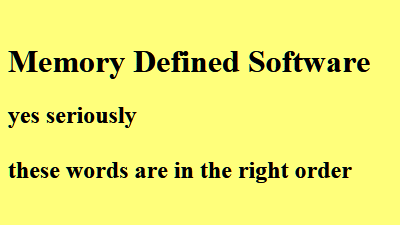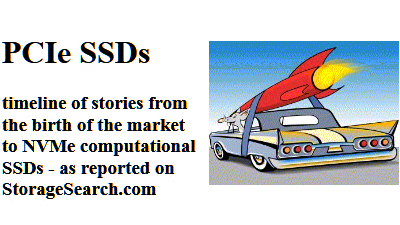|
|
|
|
|
|
Diablo invites ISVs to play with Memory1 at
new experience center
Editor:- June 28, 2016 - Diablo Technologies
today announced the opening of its ISV Development and Customer Experience
Center at the company's Silicon Valley office in San Jose, California. This
will be the main hub for hands-on demonstrations and customer engagement
activities related to Diablo's Memory Channel Storage and Memory1 (DIMM wars)
products.
Virtium offers encryption in all its industrial SSD form factors
Editor:-
June 28, 2016 - Virtium
today announced self-encrypting drive features as options throughout all the
form factors in its StorFly range of industrial SSDs.
"These
support multiple SATA form factors, including 2.5", 1.8", Slim SATA,
mSATA, M.2, and CFast. Additionally, they support all 3 StorFly reliability
classes – CE (MLC), XE (industrial-grade MLC) and PE (SLC)" said Scott Phillips,
VP of marketing at Virtium.
Virtium says many industrial-system makers
and their customers continue to push functionality closer and closer to the
network edge and the end-customer. This puts systems and the data they hold at
risk of hacking and data theft. Virtium's new SEDs provide security for
data at rest without sacrificing industrial features.
placing 3D XPoint claims in context
Editor:- June 23,
2016 - If you've been trying to renconcile Intel / Micron competitive
claims about
3D
XPoint compared to flash and DRAM - it has been problematic due to absence
of adequate hard data.
A new video -
3D XPoint, reality,
opportunity, competition - by Sang Yung Lee,
President & CEO - BeSang
- places the known features of 3D XPoint into context, and looks at the
limitations, manufacturing costs and best likely application roles for this new
technology.
If you're interested in analyzing the impact of
DIMM wars
in your future plans - then the 12 minutes you spend listening to the narrative
in this video will remove any mysteries of how the IM technologies could fit
into the pattern of adoption and just as important - you'll see where 3D XPoint
is unlikely to be the best fit technology too. ...watch the video
Mangstor has P2P in NVMe-based PCIe SSDs
Editor:-
June 22, 2016 - Mangstor
announced that its MX-Series family of NVMe-based PCIe SSDs now features
higher capacity 5.4TB usable models (FHHL) as well as Peer-to-Peer (P2P)
capabilities which provide low latency access to an extremely large storage pool
of non-volatile memory, bypassing host resources.
The
new models have been shown this week at the ISC
High Performance Conference in Germany.
""Our innovative
ability to separate data control from the data path optimizes I/O, reduces
latency spikes and system bottlenecks, and delivers accelerated performance"
said Paul Prince,
CTO for Mangstor
can memory do more?
Editor:- June 17, 2016 - in a new
blog on StorageSearch.com -
I ask - where are we heading with memory intensive systems and software?
All
the marketing noise coming from the DIMM wars market (flash as RAM and Optane
etc) obscures some important underlying strategic and philosophical questions
about the future of SSD.
When all storage is memory - are there still
design techniques which can push the boundaries of what we assume memory can do?
Can we think of software as a heat pump to manage the entropy
of memory arrays? (Nature of the memory - not just the heat of its data.)
Should
we be asking more from memory systems? ...read the blog
QLogic to be acquired
Editor:- June 15, 2016 - QLogic
today announced
it has agreed to be acquired by Cavium
in a transaction worth approximately $1.36 billion.
Editor's
comments:- Cavium describes
itself as a "provider of highly integrated semiconductor processors that
enable intelligent networking, communications, storage, video and security
applications."
Micron's Inotera deal put on ice
Editor:- June 10,
2016 - Micron
has announced
that it will not be completing the acquisition of Inotera in mid July as
previously anticipated.
Instead - "Micron expects to provide an
update toward the latter part of calendar 2016."
Editor's
comments:- the DRAM
market is not what it used to be.
The demand for DRAM is expected by
market researchers to
shrink dramatically in the next 5 years due to retiring and retiering
enterprise DRAM (SCM
DIMM wars having been one of the
big SSD ideas
of 2015).
And this year we've seen companies like
Marvell showing that
the flash as DRAM substitution concept might work effectively at cell phone
scale too.
I had doubts about interpreting the Inotera acquisition
as a RAM deal when it was announced in
December 2015.
Here's what I said then.
"Why does Micron want more RAM capacity?
A semi-serious interpretation might be - it's a poison pill. Who would want to
buy a RAM company? Except Micron which knows RAM. Another interpretation is
that - by paying a premium price for Inotera - Micron is saying it is worth more
too. We've seen this kind of huff and bluff many times before in the storage
market. It doesn't always follow that the valuations are sustained. On the
other hand - it may be nothing to do with RAM at all. It can be viewed as a
convenient way of buying more semiconductor wafer fab capacity in readiness for
a market in which the SSD ecosystem will be able to consume more memory than all
the chip companies currently make."
The longer the delay the more
likely that the terms of the deal will have to be rethought.
A blog on
Seeking
Alpha about this delay by financial blogger Electric Phred
says "Inotera's CFO
Peter Shen has
resigned."
See also:- an
SSD view of semiconductor memory boom-bust
Weka.IO has raised over $32 million for its SDS cloud cookbook
Editor:-
June 8, 2016 - another new name unstealthing in the software defined storage
market is Weka.IO, founded in 2014,
which has
announced
the closing of Series B funding bringing its total capital raised to over $32
million.
Editor's comments:- In various
slideshares by Weka.IO
cofounder and CTO - Liran
Zvibel - you can see how they're progressing with their big idea of
enabling clouds and enterprises to have a single software based storage
solution with good performance, efficiency and scalability.
There are
interesting comments here about the latency impacts of garbage collection
within the D software development environment.
Zvibel says an
infrequent (few times an hour) latency of 10mS for GC can become an infinite
wait if the kernel is stressed on memory.
The
variability
of DRAM latency took many years to be widely appreciated and is what
created opportunities for PCM
and flash as DRAM (Micron
and Diablo in
SCM DIMM wars)
and also big PCIe RAM fabrics likes those from
A3CUBE.
what
was the spark of opportunity for Weka.IO?
Liran's slideshare
(from 2014) -
the
future of the data center - includes this comment:- "IBM, Oracle,
Microsoft, SAP, Dell and the like lost their ability to shape the future of
data centers."
See also:-
SSDs in the cloud,
SSD software,
towards
enterprise storage systems consolidation | |
| . |
| What happened before?
|
| . |
 | |
| .. |
What do want our memory
systems to do for us?
And how do we want them to behave?
An emerging trend has been to demand much more from memory systems,
and to offload data compute and other functions where ever it makes more sense
from an energy and performance point of view to perform such functions inside
the memory array. |
| there's more to
upcoming SSD change than DIMM wars | | |
|
. |
|
 |
|
. |
|
|
|
. |
|
|
|
|
|
 |
|
. |
|
| the Top 10 most viewed SSD
articles on StorageSearch.com in June 2016 |
- home page - unlike many other
sites - our home page is also the place where many new SSD articles begin.
The home page blog in June 2016 was -
where are we
heading with memory intensive systems and software?
.
- the Top SSD
Companies - in 36 quarterly articles this series has provided the answers
to this question:- Who are the top SSD companies?...the companies which you
absolutely have to look at if you've got any new projects involving SSDs?
.
- SSD news - gives
you a real-time view of the whole SSD market from chips to cabinets.
.
- SSD
endurance - this is the "forever war" in the flash SSD market -
managing flash endurance. New factors in the market are the overlapping
capabilities of memory types due to geometry effects (3D), architecture (TLC and
OLC) and virtual hardening.
.
- Charting
the Rise of the Solid State Disk Market - tracks SSD market history from
the 1970s upto the present day. It includes significant events from
thousands of SSD news stories and first hand conversations with the people
who built this market.
.
- high
availability and fault tolerant SSDs - news and articles.
.
- the SSD Heresies
- Why can't SSD's true believers agree on a single shared vision for the
future of solid state storage?
.
- what's the state of DWPD?
- when this article began SSD makers only listed DWPD for enterprise drives
but since then the usefulness of this role descriptor has expanded the scope
of this article to all markets.
.
- the
upside and downside of hold-up caps in MIL SSDs - looks at the extreme
design boundaries of hold up times in 2.5" military SSDs and the
consequences of these design approaches for deployments.
.
- SSD controllers &
IP - this is a directory of merchant market SSD controller chip technology
providers and related articles.
. | | |
|
. |
|
 |
|
|
|
|
|
| |














